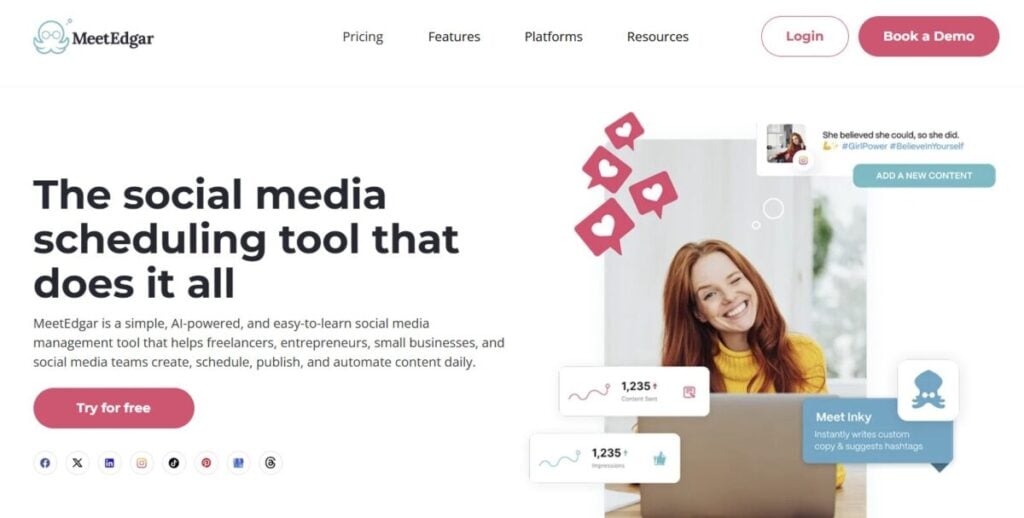A well-organized social media content calendar can simplify your daily routine by streamlining your social media posting.
If you operate business social profiles, then you need to show a positive ROI. You need to run your accounts strategically, not just throwing up any old post at a whim. With your 2025 social media content calendar, (or 2026, 2027 or any year in the future) you can ensure that you use your time wisely, and work towards meeting your marketing goals.
You have many options for preparing a social media content calendar. You could create one in a spreadsheet or Word document. Another option you could consider is to use one of the specialist Social Media Marketing Platforms. We have reviewed quite a few of these here.
- Why Use a Social Media Content Calendar?
- Audit Your Existing Social Media Accounts and Needs
- What Types of Social Media Content Will You Share?
- A Suggested Layout for Your Social Media Content Calendar
- Using Your Social Media Content Calendar
- Perfecting Your Post Content
- Don't Forget to Add Visual Content to Your Posts
- Include Themes in Your Yearly Social Content Planning
- Make Your Posts at the Best Times for Your Social Audience
Why Use a Social Media Content Calendar?
Running a blog or website can be hard work. You have a seeming never-ending To-Do list, and you're competing with every other site in your niche in the world. And despite what some people think, you can't just write a blog post or page of web copy and expect it to appear at the top of the search engine rankings automatically. It takes much hard work to gain a place on the front page of Google for virtually any popular search.
Social media marketing can be just as tricky. It may be fine making your personal posts ad hoc on a random basis. But that doesn't work for a business that has to justify everything it does, where managers have to show an acceptable ROI on virtually every activity. You need to think through your social media posting carefully. You have to look at your posting from a strategic viewpoint, ensuring your posts meet the goals your organization sets.
Many businesses run their social accounts as a team. If you create a social media content calendar, you can ensure that every member of your team is consistent in their postings. Even if you run your accounts solo, it can help you see the bigger picture and ensure that your posts reach the right audience at the right time for maximum impact.
Audit Your Existing Social Media Accounts and Needs
Unless you are setting up new social accounts for a company for the first time, you should first begin by taking stock of the existing situation for your organization. Which channels are you currently using? What types of content are you sharing?
Begin by determining your existing social accounts. You want to include every account operated by your organization. Include any that may currently be run independently, perhaps by a separate department, or because they were outsourced in the past. It's worth doing a quick search for any rogue accounts that may have been set up previously and forgotten about.
Once you've found all of your social channels, you need to consider three things:
- Where is your audience currently? Do your social followers roughly correlate with the types of people you want as customers?
- Have you had any noticeable growth on any channel over the last year?
- Are there any social accounts that drive more traffic to your website, or which have better engagement than the others?
Unless you are a large organization with a broad client base, you do not need to spread yourself across all of the social channels. You need to be where your audience is. And there is little point having a substantial social audience of the wrong types of people for your product. Ideally, you want the people who follow you on your social channels, to be the same types of people who would buy your product.
What Types of Social Media Content Will You Share?
You also need to figure out the types of post you should make. Again this will relate strongly to your target audience. You want your social posts to add value to these people's lives. If you are a B2B company, for instance, with conservative customers, you aren't likely to gain benefit by sharing lots of funny cat videos or off-color jokes on your social sites. If you target Millennials or Generation Z, there is little point making posts that look explicitly like advertisements.
The main types of posts that you can make and share are:
- Images, either single-image or gallery posts
- Videos, including your own video content, and live streaming
- Text – where the words (copy) says all that is important
- Links – links to external content on websites
- Links to your own posts or website pages
- Curated posts linking to other sites
Different audiences will favor some of these post types over others. Also, your social team will probably be stronger at creating some types of posts than others.
If you look at the analytics or insights provided by each of the leading social networks, you should be able to get a good indication of the type of posts that your followers currently prefer. You will be able to see which posts have the most impressions, and perhaps more importantly, engagement. Do your followers, for instance, share image posts moe than they do pure text posts. Do they click through links in the posts you share? Do they spend time watching your live streams?
You may have to go to the Analytics sections of each social account for this information. However, if you currently use a Social Media Management Platform, you may find that they show post analytics for all your accounts there. Look for general trends and preferred post types.
A Suggested Layout for Your Social Media Content Calendar
Once you have analyzed your past performance, you should look at how you intend to operate your accounts in the future. You can do this by setting up your Social Media Content Calendar. If you are using a Social Media Management Platform, then you will want to look for some form of Calendar View. Most of the leading apps have them, although they name them differently. You may not be able to include all of the information on the calendar, so you may wish to run a cut-down version of a spreadsheet alongside it. If you are using a platform, use the layout of their schedule for your planning.
Your spreadsheet will have columns for every day of the week on which you intend to post. On each day, you want to have columns for Copy, Image Link, and Post Time. This will cover 21 columns if you intend to post over a 7-day week.
You need to have a row for each post you intend to make on a particular social account on any day. For instance, if you plan to make a Facebook post, a LinkedIn post, 2 Instagram posts, and four tweets on your busiest day, you will need to allow eight rows beneath your headings.
Using Your Social Media Content Calendar
The basic idea is that you pre-write each of your posts in your Social Media Content Calendar before you transfer the details into the actual post.
Select the date you wish to make your post. Make sure that you enter the post data into the right columns for that day. You will want the first cell to correspond with the social network you're using. For example, if you're planning a Facebook post, make sure you type it in on a row beginning with "Facebook" in column A.
Write the words for the post into the Copy square. Remember that most of the social networks have limitations on the length of your posts, 280 characters for X (Twitter), for example.
If you include a picture in your post, add the link to the image in your Image Link column. We will look at that in more detail below.
Don't forget to set a suitable time to make your post.
Finally, if you're using a spreadsheet, transfer both the post copy and link details to your social account when it's time to make the post.
If you're using the calendar in your Social Media Content Manager, you won't need to transfer your post at all – you are creating it as you plan it (and scheduling it for delivery at the right time). You will probably also upload your image as you build your post in your social media management app, so won't need to record an image link.
Perfecting Your Post Content
You earlier decided the best types of posts for your audience. Therefore you should allocate slots in your social media content calendar for the different types of posts you intend to share. For example, you might decide to share a link post to your latest blog post every Thursday afternoon on Facebook, X (Twitter), and Instagram. You might choose to share a predominantly visual post every Friday morning on Instagram.
You could consider color-coding your calendar for the different types of posts, so you can see what you should include in each slot.
Some of the social media marketing platforms can help you with this process. Meet Edgar is particularly strong, placing a big emphasis on social media categories. You designate a category to each time slot and Meet Edgar automatically selects an item of that category type to go into the queue at that time. PromoRepublic also makes good use of categories and provides exceptional tools to help you make your visual posts in particular.
There are a few specific points you should bear in mind when writing copy for your posts:
- Make sure that you check your posts for correct spelling and grammar. Consider using a tool like Grammarly to help you
- Write in the active voice rather than the passive voice, whenever possible
- Use the word "you" more than you do "I' or "we."
- Write clearly and concisely. Keep within any character limits for your social media account, e.g., 280 characters on X (Twitter)
- Deliver value to your audience. Create posts that other people will want to share. Avoid blatant ads.
- Use hashtags, particularly on X (Twitter) and Instagram. Don't overuse them, though. You can use more on Instagram than on X (Twitter) (where you should limit yourself to two hashtags per tweet)
- If you link to an external page in your posts, make sure that the linked page is relevant for your post. Avoid connecting to generic pages, like your home page
- If you have visuals in your post, make sure your copy matches the visuals
Don't Forget to Add Visual Content to Your Posts
Visual content is vital for many of your posts. Indeed you will often start a post on Instagram or Pinterest with the image, rather than the copy.
If you're working with a team, you will probably find it easiest to upload your images to somewhere like Dropbox or Google Drive to give everybody access to the pictures and videos. Show the link to the relevant image in your social media content calendar.
Always select good quality images for your posts. We have written about the best images sizes for social media, and it's a good idea to modify your images to be as close to these as possible. It is far better to adjust your images in an image editing app rather than using the tools in the social apps, as this can reduce the final sizes you have to upload to share. We also have the optimal sizes for sharing video on social media.
Include Themes in Your Yearly Social Content Planning
It can sometimes be challenging to think up topics for your posts. You could consider adding posts connected to popular events to your calendar. These could include posts on:
- Holidays
- Special Days – if you use PromoRepublic you will find a full list of these directly within the platform
- Events – either your own or larger-scale events (such as the World Cup, Americas Cup, Olympics, Elections, local trade shows, etc.)
- Product launches
- Specific themes relating to your organization
You could color code these in your social media content calendar.
Make Your Posts at the Best Times for Your Social Audience
You need to think carefully about the times you schedule your posts. You want to schedule them when your followers are most likely to be online checking their social posts. You will need to take into consideration where most of your audience is located, making sure that you are posting according to the correct timezone for your most significant audience.
There are many different ideas about the best posting times. CoSchedule analyzed the results of 25 studies and came up with a detailed list of the best times to post on each of the leading social networks for different types of business social accounts. Also, consider incorporating Social Media Scheduling Tools into your strategy to automate and optimize your posting schedule, ensuring consistent engagement. Check out our article detailing the best times to post to Instagram for further insights.




